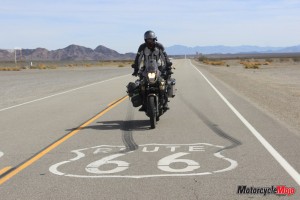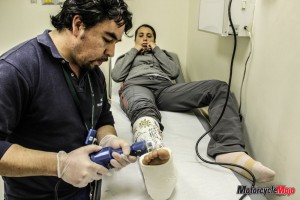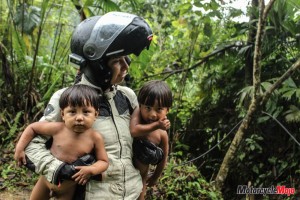A snapshot into the lives of two travellers after 1,275 days on the road, 45 countries visited and 125,628 km riding two up – so far . . .
The word Gaia loosely translates as “Mother Earth” in Greek mythology. So, how long would you spend planning a four-year motorcycle trip around Gaia? Three months? Six months? A year? Manu Torres from Spain and Ivana Colakovska of Macedonia spent – well, they didn’t plan it at all. In fact, they didn’t even know anything about motorcycles, but they thought that seemed like a good way to travel around the world because it was cheap and accessible. They just needed a bike.

Fortuitous Meetings
The beginning actually goes back a bit further. First, they had to meet, which they did when selling jewellery to tourists on the beach in Mykonos, Greece. The two hit it off, and started travelling together, just here and there in Europe at first. They didn’t have much money, but neither is a worrier.
A short trip to India came next, where Torres and Colakovska had their first exposure to motorcycle travel. They spent three months travelling two up (she doesn’t ride) on a Royal Enfield and learned that a motorbike was a great way to travel. “It was a terrible motorbike,” says Torres. “It broke down every day. But people would appear – tools would appear – they would swarm around the motorbike and somehow it would be fixed, then they would just disappear.” Colakovska laughs. “It was like magic!” she adds. And that’s when they were bitten by the moto-travel bug.
Three years ago, they bought the Yamaha and started what they call “Around Gaia.” I ask them about the planning. “We just go,” Torres says in his typically understated way. He is a man of few words. That’s pretty much his answer for everything. How did you survive the cold mountains? How did you survive attempted robberies? How did you deal with Colakovska’s badly broken leg? How do you deal with being together 24-7 for the past three years? “We just go.”
Next to the lanky, understated Torres, Colakovska is a petite firecracker. I ask her how their relationship has survived. She rolls her eyes at Torres and laughs. He seems unperturbed. “He does not change. I change,” she says. She gives me some examples of how Torres has not changed. He looks on passively. Then from Colakovska: “I used to be more . . . easy to get angry, blow up. Now I’m more calm. Things work out. We just go.”
What Plan?

So we move on to their experiences while travelling through [at the time of this interview] 41 countries over the past three years. There are many notable memories, too many for this article. In Kazakhstan, they had to ride through mountains so high that they got altitude sickness and Colakovska had to have oxygen. Conditions were so dire that she cried, and Colakovska gives the impression of one who does not cry easily. The only thing they saw on the road was wolf tracks. They had to sign in at an army outpost at the start of the mountain road so the army could check off that they made it out alive on the other side (although no one came looking for them even though it took two weeks to ride the 800 km road). It was so cold, they had to stop every 100 km at the nearest village to warm up in someone’s hut while their clothes thawed over a fire. They were completely unprepared for the snow and freezing conditions. This was one of the times that Colakovska thought about going home. But they just kept going. Villagers would welcome them into their homes and provide extra layers of clothing for them, whatever they could spare, which wasn’t much. The conditions could have killed them. But “We just go. Now we don’t worry about weather anymore. We survived.”
We Just Go!

In India, a family in a small village took them in. It was a great honour for the father to host them in his two-room home. One room is for the animals so they won’t fall victim to predators, and the other for the family. Their host insisted they sleep in the family bed while he sleeps on the floor at the foot of the bed to keep an ear open and ensure no one messes with their bike. In the middle of the night, the father heard a sound and fearlessly rushed outside with a bow and arrow to protect the Yamaha.
In Australia, the greatest threat was a kangaroo. Apparently, they like to jump into the light created by vehicles after dusk. No one wins in that situation.
Sidelined
In South America, on a snot-covered road, the bike went down and Colakovska put her foot out to try to catch it. The aluminum pannier snapped her leg and they were three days from the nearest hospital. This was the second time she considered going home, but was determined to stay. In a local village, a “sort of pharmacist” set her leg as best he could for the three-day trip to the hospital. She was in excruciating pain. But they made it. Nine screws later, the surgery was over and she was told that she can’t get back on the bike for six months. This was a devastating blow. Not so much because her leg was broken, but because they couldn’t “just go.” At least for a while.
Colakovska was “adopted” by a local Chilean family and treated like a daughter. She stayed with this family for an entire month, being fed and bathed in bed, the woman lifting her up to change her sheets every day “to get rid of the bad energy.” It seemed to have worked, as Colakovska was back on her feet (with a plastic boot) in a month. But what to do? Torres was anxious to move on. The two decided that Colakovska would hitchhike on the main road with truckers and Torres would meet her each night in a new town, having explored back roads. Sometimes he would be several hours behind her arrival, but they were moving.
Personally, I don’t think my wife, Janiebelle, would go for this arrangement.
Colakovska hitchhiked for a month on crutches; then they took off the boot and she was back riding (with the crutches lashed to the bike), four months before the doctors had predicted.
At Gunpoint Twice in One Day
In Mexico, someone tried to steal their bike from them at gunpoint. They quickly rode away, with no shots fired. Then it happened again on the same day. This story elicits a smile and shake of the head from Torres. He seems unfazed. Those are the only threats they’ve experienced on the entire trip.
To make ends meet, they barter for maintenance and repairs on the bike by doing presentations for customers at motorcycle dealerships. One Triumph dealer had been too busy to let them put on a presentation, but installed new front brake discs anyway. They sell some stories to magazines in Spain and the U.S. They post stories and photos to multiple online media sites. They develop merchandise that they can sell at events and through Facebook (facebook.com/aroundgaia) and their website (aroundgaia.com). They even pick up sponsorship from companies like Givi, Sena and Rev’it! They camp. They couch surf. They carry on.
Three years into the trip, they’ve ridden through Europe, Asia, the west coast of the Americas from south to north, and were almost to Alaska when trouble struck in Stewart, B.C. The bike just quit. There was no Yamaha dealer, but it wouldn’t matter anyway because their bike is Europe-only, so no parts. They found a boat mechanic named Rob who was willing to try to help after hearing their story. He and his wife took them into their home for two days while Rob diligently worked to get them going again. They took to social media for help. Someone in Europe posted a shop manual for their bike. Someone else said that they could scavenge a part from a Ford Ranger that should work (I’ve no idea how anyone could possibly know that). Amazingly, Rob got them back on their way. On to Alaska.
Storm the Embassy
But there was another, more serious problem that threatened to end their trip and their hopes to finish their world tour by travelling through Russia and Africa: Colakovska ran out of pages in her passport. Even though it was not expired, she needed a new one to continue the trip. She contacted the Macedonian consulate general in Toronto, but was told they cannot issue a passport anywhere but in Macedonia. Getting one here is impossible. Colakovska pleaded her case directly to her home country, explaining that she is acting as an ambassador for her homeland all over the world, but it fell on deaf ears. She was told that she must return to Macedonia if she wants a new passport. But her government underestimated the determination of the diminutive Colakovska. She turned to social media and launched a campaign to get the government to listen to her, posting to dozens of forums and websites. Time passed. Then the good news arrived: she could pick up a new passport in Toronto! Russia, Africa and another year of travel were once again in reach. It seems nothing can stop these two.
So, do they have a message for others? Yes, they have several: See the world up close. Don’t be afraid. If you worry too much, you might not go. People are generally good. Try to look for the best in every situation. They’ve learned that in some countries, people’s greatest fear is being able to simply survive, and yet they are the most welcoming and generous. In North America, people’s greatest fear is not having enough stuff. Experience should be valued over objects. We need few things. Stay healthy and fit. Eat simple, natural foods. While they tell me this, I treat them to hamburgers at a White Spot restaurant in Vancouver– a rare exception for them and, they admit, quite a treat. It’s been a long time since they had a hamburger, underscoring the sincerity of their message. Hamburgers aside, Colakovska and Torres walk the talk.
Around Gaia Postscript
When we last checked, Colakovska and Torres have proven to be unstoppable. They crated up their bike in New York and shipped it off to Africa. Currently in Namibia, they have been on the road more than 1,275 days and have ridden through 45 countries. After using a shirt from one of their sponsors as a “gift” to pave the way for a prickly border crossing, they continue to learn the ways of world travellers.





































